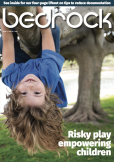Did you know?
There is no one way to meet documentation requirements under the NQF. Approaches to documentation should reflect the children, families and communities of your service. To ensure documentation is meaningful and authentic for children’s learning to be made visible, educators, teachers and service leaders use their professional judgement in selecting methods that best reflect the intent and purpose of the documentation.
Approved providers should provide support to educators, teachers and service leaders and collaboratively set expectations to ensure documentation meets legislative requirements as well as to encourage continuous improvements of programs and practice.
Approved providers should also empower and encourage educators and teachers to explore a range of styles and methods to determine what works best for their unique setting including the children, families, service and community.
In settings or collaborating on processes to meet the requirements of the National Law, National Regulations, NQS and align with the approved learning framework it is important to:
- consult with and empower educators, teachers and service leaders to build ownership of andcommitment to agreed processes and expectations for documentation
- focus on the primary purpose of documentation
- ensure expectations/benchmarks are sustainable, reasonable and achievable
- eliminate or minimise duplication
- ensure documentation practices complement (rather than hinder) educators’ and teachers’ engagement in valuable learning experiences and interactions with children
- ensure that educators, teachers and service leaders have the appropriate resources (including time and professional development) to successfully undertake the documentation.
To ensure that documentation processes remain fit for purpose, sustainable, contemporary, meaningful and continue to meet the legislative and quality standards, it is worthwhile to implement regular collaborative practices and provide time for educators and teachers to focus on and streamline documentation processes.
Listening to and empowering educators, teachers and service leaders is a key component to ensure documentation methods are manageable, implementable and reflect their pedagogical and philosophical approaches.
To ensure documentation expectations are met, educators and teachers should be provided with adequate non-contact time to effectively document and plan for children’s learning.
Approved providers should refer to relevant employment awards for educators and teachers in relation to non-contact allocations for staff members responsible for educational documentation and consider the varied roles and workload of each educator and teacher.
Excessive and/or duplicative documentation practices may be overwhelming or burdensome and have negative impact on educators and teacher wellbeing.
Excessive and/or duplicative documentation also undermines the aims of the NQS by diverting educator and teacher energy and time to administrative work, rather than planning and assessment of rich learning experiences.
Educational leadership
It is important to consider how the role will continuously support educators and teachers and ultimately improve outcomes for children and families.
If the educational leader has a strong voice in the decision making of the educational program and documentation, they are more likely to be successful in their role and fulfill their responsibilities under the National Regulations.









































































































































